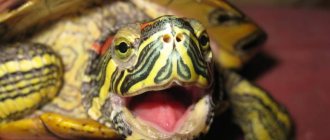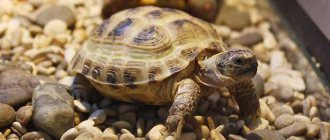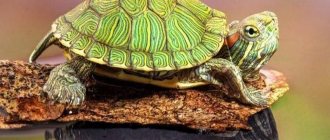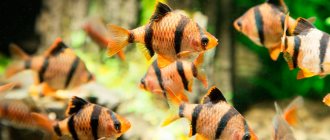The world of turtles is diverse: more than 300 species, united in 14 families. There are two main species based on their habitat: marine and terrestrial. Terrestrials are divided into land and freshwater.
At home, there are land Central Asian and freshwater turtles - red-eared (yellow-bellied), marsh, trionics (Far Eastern turtle). Read more about turtle species in a separate article.
Let's look at the external features and care of these species using the example of the red-eared turtle (Trachemys scripta) and the Central Asian turtle (Agrionemys horsfieldii).
Appearance
A turtle at home is exotic, and its appearance is also unusual.
Animal body:
- head and eyes;
- neck;
- beak and tongue;
- shell;
- color;
- limbs;
- tail;
- dimensions.
The head of these reptiles is streamlined and designed in such a way that the animal can quickly pull it under its shell. In some species, the length of the neck is equal to the length of the shell.
These animals have a strong and hard beak with bulges inside, with sharp or jagged edges that act as teeth.
The function of the shell is protection. The dorsal (upper) part is called the carapace, the ventral (lower) part is called the plastron.
The size of a turtle is measured by the length of its shell. Determine the length using a ruler despite the fact that the surface of the dorsal part is uneven.
They grow slowly throughout life. In adult individuals, the length of the carapace is 20–30 cm.
The tail is hidden inside the shell. The tip of the tail in some species is pointed, similar to a spike.
Differences between Central Asian and red-eared cats in appearance
| Appearance | Central Asian | red-eared |
| Color | Yellow-beige color, shapeless dark spots on the shell. | The carapace has characteristic stripes of olive, black, and yellow colors. |
| Plastron | Dark color. | Smooth, variegated color: dark spots on a yellow background. |
| Head | The upper jaw is hooked. | From the eyes to the neck, on both sides there are yellow-red lines resembling ears. |
| Eyes | Located on the sides of the head in such a way that they look down; small, black. | Directed forward and upward, located near the crown. |
| Limbs | The front paws are flat, designed to dig soil, and the hind paws are powerful and strong. They have four toes on their front paws with blunt claws. | The feet have leathery membranes for swimming. |
| Dimensions | Cubs are born 3–3.4 cm long and weigh 10–12 grams. By the second year of life, the size will increase to 5 cm, by the fourth to 9 cm. The weight of an adult turtle grows to 2 kg. | A newborn cub is 2.4 cm long, and during the first year of life it gains 2.5–4.5 cm. At two years, its size will be 8 cm, at six years - 18 cm. |
Sense organs
Turtles have good low-frequency hearing and excellent color vision.
Red-eared turtles have an excellent sense of smell and smell. They see both in water and above water. Hearing is like that of cats: they can distinguish dull sounds and vibrations. Nerve endings pass through the shell. Animals with a sense of touch distinguish the taste of food.
Aquatic turtles are not adapted to breathe underwater; they swim up for oxygen.
Lifespan
The average lifespan of these animals in their natural environment is 20–30 years. If kept at home, if the rules of care are followed, pets will live up to 40-50 years.
In captivity, these reptiles grow faster as they receive high-quality nutrition and a comfortable life.
When determining age, they are guided by size and also count the number of rings on the shell. In one year, 2–3 rings are formed. But this growth is not uniform; it is influenced by conditions of detention, illness, and hibernation.
In older individuals, the carapace is smooth, the growth rings are pale. The younger the turtle, the brighter its color.
Inappropriate maintenance and disease are the main causes of death.
In another article, we took a closer look at how long turtles live.
Requirements for aquatic reptiles
Often, pet stores sell coin-sized babies and convince the buyer that a 30-liter aquarium will be the ideal solution. This is mistake. Even for a small reptile, the aquarium must be spacious, but for an adult, it must be taken into account that a minimum of 200-300 liters of water will be required.
Effective filtration is required, preferably in the form of an external filter, appropriate lighting, including UV, and a proper diet. Aquaterrariums use soil and gravel.
Caring for a turtle at home
Arrangement of living space
Pet turtles should not wander around the apartment randomly. Keeping turtles requires organizing a separate closed space for them: a terrarium or an aquarium with special equipment.
List of necessary equipment (for all types):
- room/container for keeping (terrarium/aquarium);
- ultraviolet lamp (for water UVB 5–10%, for land 10–12%);
- heater/heating lamp;
- lamp;
- thermometer for temperature control$
- stable feeder.
For land turtles, this list includes a house for sleeping and resting.
Additional equipment for aquatic species:
- 100 Watt water heater;
- filter (internal or external);
- land/shore/island.
Although red-eared aquarium turtles spend most of their time in the water, provide them with a warm, dry place on land to rest and get UV exposure. The turtle will not turn it over if one side is submerged in water. Requirements for material for sushi: non-toxic, not smooth, but rough, without sharp corners. Observe the following proportion: water – 3 parts of volume, land – 1 part.
In their natural environment, turtles climb onto snags, stones, and stable objects protruding from the water. It should also be convenient for them to climb onto the artificial shore in the aquarium.
The required aquarium volume for a red-eared turtle is from 200 liters. The more spacious the home, the healthier the animal.
For land use, you need a terrarium with a capacity of 100 liters or more. Entirely glass or made of wood, but with one wall made of transparent material.
House
So that the pet can sleep peacefully, relax, and hide, it needs a home inside the terrarium.
A ceramic flower pot, divided in half, with processed edges, is suitable for the house. Use a plastic rodent house for this purpose or make one out of wood.
Priming
In terrariums, use hay as soil - it is easy to change. Do not put sand on the bottom as animals will swallow it. Lay a two-layer coating: sand at the bottom, large pebbles at the top. The turtle sharpens its claws on it.
Do not put newspapers, expanded clay, sharp stones, or cat litter in the terrarium.
Aquatic turtles do not need soil. For aesthetics, place large stones at the bottom of the aquarium. Gravel or other covering will not work; the animal will swallow it.
Water
Clean water and a maintained temperature level are the most important things in keeping aquatic species.
In the water, the red-eared turtle swims, sleeps, eats, and goes to the toilet. To prevent ammonia, nitrates and unpleasant odors from accumulating, change the water a couple of times a week. At the same time, carry out filtering.
Before replacing, let the water settle so that the chlorine evaporates and the temperature returns to room temperature. A comfortable water temperature for them is 22–28 degrees; cooling the temperature below 20 degrees is unacceptable.
For aquarium turtles, the water level exceeds the width of its shell so that they swim and roll over without touching the bottom.
Outside of an aquarium with water, the red-eared slider will only live for a couple of days.
Shore heating
For the Central Asian land bird, a heater is installed near the feeder. The required air temperature is 26 degrees.
Aquatic turtles come to the shore to warm themselves. The surface is 10 degrees warmer than in the water. Avoid overheating - hyperthermia of the animal; permissible temperature on the shell is 30–35 degrees.
To avoid getting burned, the lamp is hung above the reptile, but not too close. Monitor your pet when sunbathing. Make sure that the lamp is not exposed to splashes or vapors from water.
The daily operating mode of the incandescent lamp, heater and UV lamp is 10–12 hours.
Lighting
Ultraviolet rays and heat help absorb calcium and produce B vitamins. Without this, the animal risks developing rickets, and the horny surfaces will be curved.
A heating lamp or UV lamp is placed above the turtle. Change them every six months.
Feeding
The diet of land species is mainly plant-based:
- vegetables (carrots, cabbage, cucumber, lettuce);
- greens (plantain, dandelion);
- fruits (apple, melon, watermelon);
- berries (raspberries, strawberries).
Offer various porridges (oatmeal, semolina, buckwheat).
To add vitamins to your regular diet, add foods high in calcium, raw minced meat, and boiled eggs. Give calcium as a food additive.
The Central Asian turtle receives the bulk of its liquid through food, as well as through the skin when taking a bath. They don’t give them a drink with liquid, and they don’t drink water separately.
Diet of the red-eared slider:
- 70% – plant foods (lettuce, cucumber, zucchini, nettle, algae, duckweed);
- 30% – animal (meat, fish, seafood, worms, insects, bloodworms, guppies).
Aquatic turtles are omnivores. Feed regular food and artificial food, fish food, aquarium plants and insects.
Feed turtles up to two years old once a day. During this period, animal protein predominates in their diet. As the animals grow, the proportion of plant feed increases.
Vegetables are included in the diet, even if the animal does not show an appetite for them. The older it is, the more fiber it needs.
Feeding regimen for adults: once every two to three days. Do not overfeed your pet. To maintain a balance in nutrition, special feeds have been developed.
Aquatic turtles use water for swallowing as they do not produce saliva. They eat in the aquarium. It is better to feed them in a specially designated place, this will keep the home clean longer.
You can read more about what turtles eat at home in a separate article.
Hygiene
Cleaning the premises
Clean the bottom and walls of the terrarium from animal waste products every day. Wash feeding and drinking utensils whenever they become dirty.
The aquatic turtle's aquarium also needs general cleaning twice a month.
Bathing
Caring for land turtles includes weekly water treatments. Place the animal in a small container with warm water at a temperature of 30–35 degrees for half an hour. The head should be above the water. Dry your turtle after bathing.
Trimming claws
During their lives, these animals grow a shell, beak and claws. Care for your pet turtle's claws.
When the beak and claws grow to such a size that it becomes difficult for the animal to move and eat, remove them. For this procedure, special nippers are used.
Such actions are not done with aquatic species of turtles.
Shedding
Turtles are susceptible to molting.
In aquatic species, the separation of large scales on the shell and the change of skin occur regularly throughout life.
Land turtles only change the skin on their paws, this happens unnoticed.
Home improvement
Contrary to popular belief, you cannot let a turtle “free swim” around the apartment. A pet can climb into a secluded place from which it cannot get out, get under the feet of someone in the household, or catch a cold. In this regard, it is advisable to keep the animal in a terrarium.
The optimal solution may be a terrarium with transparent walls from 50 cm in length and from 30 cm in width. A worthy alternative could be a house in which all the walls (except the front) are made of opaque material - plastic or painted wood. The main thing is that the material washes well: this will make it easier to care for. You can create such a terrarium with your own hands.
Two lamps should be hung above the terrarium. The first one is with a conventional lamp with a power of up to 60 W, the second one is with an ultraviolet lamp. The ultraviolet lamp should be replaced from time to time (once every year and a half) with a new one. Ultraviolet light is vital for the turtle: it promotes the absorption of calcium, which means it ensures the strength of the internal and external skeleton.
The terrarium should be covered with practical artificial turf. Some owners use natural materials for this: hay, coarse gravel and sawdust. As for the layer itself, ideally its thickness should be about 3 cm.
The terrarium must contain a “shelter” - a house in which the turtle can hide from prying eyes. You can make such a house yourself, with your own hands. It is advisable that the shelter be made of washable materials - this will make it easier to care for.
Before placing your pet in the terrarium, make sure that you have purchased a feeder and water bowl. The best option is a wide round feeder made of heavy material.
As for the drinking bowl, it can be a ceramic container or a special drinking bowl. It must be installed directly under the lamp so that the liquid in the container is always warm. Both the feeder and the drinker should have low edges or be almost flat.
A properly equipped terrarium is the key to a long and happy life for your pet.
Reproduction
In nature, animals begin mating in March and June, but at home they mate all year round. In good conditions, the female will lay 3-4 clutches of two dozen eggs per season.
Prepare a suitable nest for a pregnant female.
During pregnancy, the female spends more time on land, her need for calcium and UV rays increases.
Determination of gender
In most species, females are larger than individuals of the opposite sex. The cloaca is closer to the tail and has a star-shaped shape.
In males, the tail is longer, and the genital organ is located in it. Their claws are stronger, thicker, more curved; The plastron is curved, this helps with mating.
Red-eared sliders reach maturity within a year because they grow faster than other species. Sex can be accurately determined in males at the age of 2–4 years, in females – at 3–5 years. Then the size exceeds 10 cm. Read more about the field of red-eared turtles in a separate article.
In Central Asians, sex becomes obvious when the reptile reaches 6–10 years of age. You can distinguish a female from a male by the number of horny tubercles on the inner side of the thigh. The female has 3–5 of them, the male has one.
Handling babies
The immunity of small turtles is not strong, they are susceptible to disease, sensitive to living conditions, and have a high mortality rate. Observe the feeding of newborns, adapt their living environment.
For some time after birth, babies do not eat the food that is offered. They receive nutrition from the yolk sac on the plastron. Do not touch or remove it! When this sac resolves, the little turtle begins to feed as usual. The diet must contain food with a high calcium content.
Babies are very gentle, shy, and easily fall into a state of stress. Protect them from unnecessary worries, surround them with care. Do not pick him up unless necessary, do not stand over the aquarium, do not knock, do not make loud noise.
It is important to ensure a constant temperature for the cubs: for water 26–27 degrees and for air (land) 32 degrees. Keep the water clean, pass it through a filter, change it every two days.
Children of the red-eared turtle do not tolerate drafts or direct sunlight. Provide them with access to a place on land heated by a special lamp. Baby turtles are kept at warmer temperatures than adults.
Babies are bathed two or three times a week. The washing procedure for children is the same as for adults.
Fights and aggression
Red-eared turtles are active, strong and prone to aggression. They try to dominate the living space and attack turtles of other species and relatives, taking food from each other. They inflict wounds and bite.
If a new resident appears in the aquarium, this provokes fights among sexually mature individuals. Males attack females, causing serious injury or even death. This behavior is normal for this species of turtle.
Thoughtful care and maintenance helps reduce aggression in turtles. Try to enlarge the room where they live, set restrictions, barriers inside the aquarium so that they do not see each other.
Feed the animals one at a time behind the walls of the aquarium in a special dining area. Or keep each animal in a separate space. Red-eared turtles love solitude and live quietly without a mate.
Description of turtles
The turtle is one of the representatives of the reptile order. There are more than 300 varieties of them, divided into two large groups - marine and terrestrial. The domestic turtle is a reptile belonging to the second group, which in turn is divided into land and freshwater. If the former live only on land, then the latter can live both on land and in water. The character of representatives of different groups differs. Land turtles are calmer and easily make contact with people. Aquatic reptiles are characterized by self-will in behavior. Based on this knowledge, you can choose a pet that perfectly matches your personal preferences. Turtles are the oldest creatures, appearing 200 million years ago, when dinosaurs walked the earth. The most amazing thing is that after a huge amount of time the turtles have hardly changed.
Health and illness
Animal health is 90% determined by compliance with the rules for the care, nutrition and maintenance of turtles in a home aquarium.
Tips for keeping your animal healthy:
- for sick turtles, the temperature is raised to 27–30 degrees (for immunity);
- maintain fluid balance, avoid dehydration (the turtle should be in water, drinking);
- for a sick animal, reduce the water level in the aquarium so that it does not drown (if the turtle is a poor swimmer, it should be able to freely go ashore);
- If you suspect an infection, isolate the animal and wash your hands after contact;
- do not self-medicate, seek help from a veterinarian-herpetologist.
Hibernation
In nature, hibernation is a reaction to unfavorable environmental conditions, cold and heat. Such sleep for animals helps to survive these periods.
At home, where they are comfortable, there is no need to hibernate. Don't stimulate hibernation!
Walks
Take turtles outdoors so they get natural sunlight. Take it out into the courtyard of a house in the city, take it with you to your summer cottage.
For a walk, try to choose dry, sunny, windless, warm weather. At temperatures below 25 degrees and in other weather conditions, it is better to keep the animal at home.
Take your pet to a clean, quiet area with some shade and vegetation. She will happily eat fresh clover, plantain, and dandelion.
At your dacha, build a special pen for walking for a land turtle, and a private pool for an aquatic turtle.
When walking, provide constant supervision to the animal so that it does not eat anything harmful, does not get hurt, or runs away. Protect it from insects, animals, birds, children, from overheating and cooling.
When you get home, check your pet for any wounds or contamination. If they are very dirty, wash them.
Problems
When purchasing an exotic pet, do not forget about the following problems:
- Colds from drafts.
- Malfunctions of the digestive system due to ingestion of soil.
- Excess vitamins lead to diseases.
- Improper maintenance reduces lifespan.
Diseases
Pet turtles are easily susceptible to various diseases. Most often, owners encounter the following varieties:
- Rickets. The most common. Softening and deformation of the shell and skeleton due to lack of vitamin D. Use a UV lamp to prevent and treat. In advanced cases, a series of calcium injections will be required. Once the carapace is bent, it no longer straightens out.
- Tearfulness, swelling of the eyes. Develops due to a lack of vitamin A. Wash your eyes with chamomile infusion and drip Albucid. Contact your veterinarian, sometimes vitamin injections are required.
- Parasites. Through unwashed street vegetation, worm eggs enter the turtle. Treat with Albenazole.
- Cold. Breathing problems, white coating on the mucous membrane and viscous saliva. Treated with antibiotics.
You can avoid many diseases if you properly care for your pet.
Hibernation
Regarding hibernation when kept at home, experts have not come to a common opinion. Some aquarists believe that hibernation should be like in nature. Others argue that when kept at home, such wintering is not necessary and even harms the health of the pet if the preparation is not carried out by a specialist.
Preparing for hibernation turtle:
- refuses food;
- becomes lethargic;
- trying to dig into the ground.
Under natural conditions, hibernation occurs in two cases:
- Drought. Lack of food.
- Cold or excessive heat.
Check the living conditions, feed your pet and adjust the temperature.
Purchase
Before getting a turtle, read the description of care features and purchase everything you need to ensure a comfortable life. Be prepared for additional costs associated with keeping turtles in your home.
After purchasing, take your turtle to the vet. He will determine the age and sex of the animal, and examine it for wounds, injuries, infections, and diseases.
In a new place, the turtle will need an adaptation period to get comfortable. Do not disturb her again, provide proper care and nutrition.
If you acquire a new animal for company living, organize a quarantine zone for the newcomer for three months. Do not place cubs with adults, they will be injured. Only animals that are similar in size and living conditions can be combined in one space.
Expenses
In addition to a terrarium or aquarium with additional equipment, a heating lamp, include in the cost of good quality food, examination or treatment by a veterinarian.
Content
“I want to have a turtle at home,” parents often hear from their children. This reptile is an ideal pet for a child, recommended by doctors, because, theoretically, it does not cause allergies.
On the other hand, they are demanding and rather fragile animals. A common mistake in keeping pet turtles is to simply keep them on the floor. They need to be provided with proper temperature, humidity, soil, and safety.
First you need to decide whether the turtle will be an aquatic pet or a typically land turtle. Each group requires different conditions. If it is water-land, a suitable aquaterrarium with the required amount of water is created.
Feeding baby turtles
Small turtles are a big responsibility, and it is worth feeding them correctly. It is better to use specialized food for them. If possible, you should consult a veterinarian and choose the best option.
As feed for babies, you can buy earthworms, bloodworms, and squid meat. They need a raw product - only they have the amount of protein they need.
The size of raw food should take up 2/3 of the total diet!
A turtle's diet should consist of three parts:
- Complementary feeding with ready-made mixtures;
- Animal protein – fish, meat, seafood;
- Vegetation, vegetables.
As the turtle grows, feeding should be carried out according to the following scheme:
- In the first year of life - daily;
- Second year – after 2 days;
- Next years – in 3 – 4 days.
Important! pay attention to how much the turtle eats, and next time give it no more food than that
Aquarium setup, filling
There are several basic requirements for an aqua terrarium for a red-eared turtle. At home, such an exotic reptile needs to be provided with a sufficient amount of water. The turtle belongs to the category of freshwater animals, so the aquarium water must correspond to this feature of the pet. The standard volume of an aqua terrarium is approximately 200-220 liters. The water must be warm (22-28°C) and clean.
You also need to purchase a water heater, a special ultraviolet lamp, a thermometer and a red heating lamp, external filters and a lighting system. The turtle's home should have an island of land that smoothly extends into the water. The island should occupy at least a quarter of the total area of the aqua-terrarium. The land should not be represented by soil in the form of gravel or earth.
A high-quality, properly selected housing for a freshwater red-eared turtle should be characterized by the absence of toxic components, maximum stability, and the absence of sharp corners or burrs.










